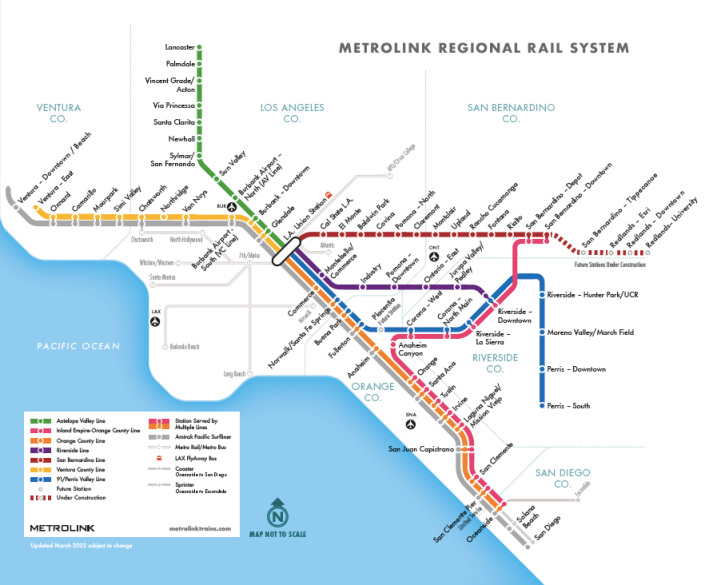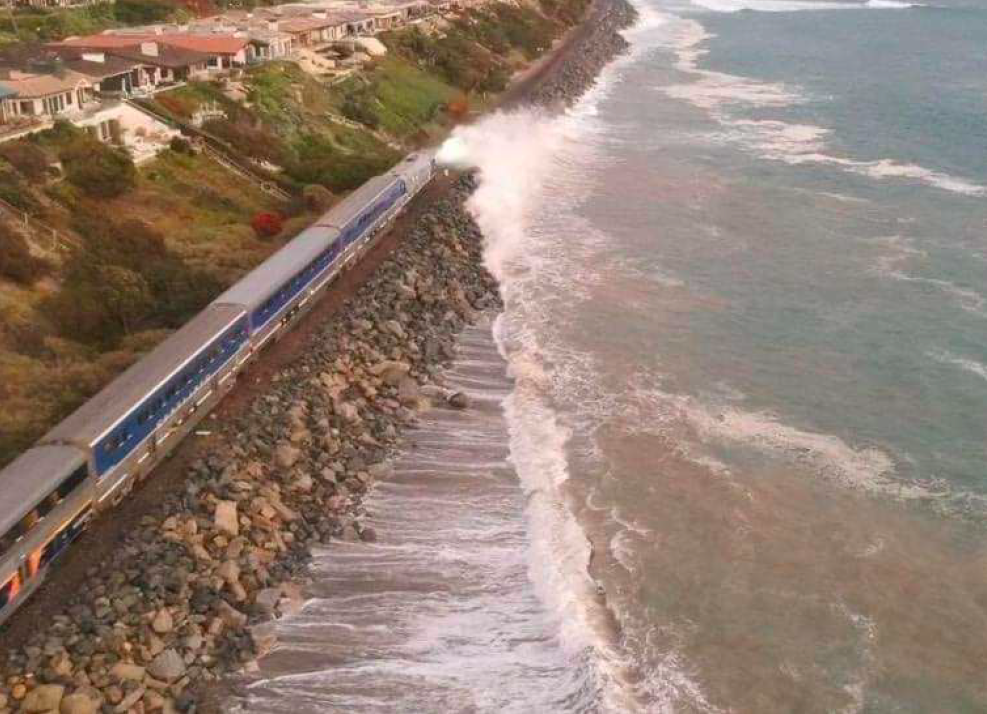Train service between San Diego and Los Angeles has been disrupted by the threat of a landslide near San Clemente. Metrolink has suspended all service between Laguna Niguel/Mission Viejo Station and Oceanside, and Amtrak's Pacific Surfliner is not running trains between Irvine and Oceanside. Freight service on the busy corridor has also been halted.
The California Transportation Commission yesterday greenlighted an emergency allocation of $6 million from the State Transportation Improvement Program (STIP) for a temporary fix. The Orange County Transportation Authority (OCTA), which owns the railroad right-of-way between Fullerton and San Diego County, also held an emergency meeting to authorize work to begin. The agency is "working with state and federal officials to secure all necessary funding to pay for the emergency construction," which is estimated to cost a total of $12 million. The hope is to get the tracks back in service by mid-November.
But that is only for an emergency strategy to get rail traffic back up and running. A longer term fix, potentially involving moving the tracks away from the coast, is not part of the current project.
A photograph presented to the commission by OCTA show a nearby beach completely washed away and waves crashing up onto the tracks. Other bluffs in the area have also been failing over the last five years, causing numerous service suspensions, including in February of 2021 when a seawall collapsed in Del Mar, coming close to the tracks and requiring an $11 million repair job.
In September of last year, according to Jim Biel, director of capital programs for OCTA, "very significant beach erosion activated a historical landslide" on the bluffs near San Clemente. While only a portion of the threatened slide came down at the time, the railroad tracks moved about 28 inches closer to the ocean. Metrolink and Amtrak suspended service while repairs were made, including placing 18,000 tones of riprap - large chunks of granite commonly used to protect shorelines in California.
Then in September of this year, monitors placed at the site showed more movement on the bluffs, likely spurred by high tides and storm surge. Another 2,100 tons of riprap were put in place, and trains were slowed through the area.
Engineers determined that the larger mass of the "historical slide" had begun to move, and came up with a plan to place ground anchors within the cliffs to help stabilize the hillside. The potential slide also threatens a number of houses on the bluffs above the tracks. Biel told the CTC that two of those houses are "red-tagged" already, meaning they are not safe to enter.
Biel acknowledged that this is an emergency strategy, not a long-term fix to the problems plaguing the tracks there and in other areas nearby. "We have looked at realignment and relocation of the tracks, and anticipate more conversations on that topic going forward," he said. "But it's very complex."
For example, discussions about potentially moving the tracks near Del Mar into tunnels are at an early planning stage.
Biel said this is "the second busiest intercity passenger rail corridor in the U.S." Amtrak's Surfliner carries about 4,500 passengers a day, and even more travel daily on Metrolink commuter trains. According to the Orange County Register:
Thirty years ago, when the OCTA took over the right-of-way, [fewer] than two million people traveled by train a year. According to its latest figures, tallied just before the pandemic hit, an estimated 8.5 million people used the line annually, equivalent to an entire lane on the 5 freeway.

Commissioner Joseph Tavaglione reminded the other commissioners that the $12 million cost estimate is "only an estimate. With this type of project, anything can happen," he said, pointing to the alarming amount of recent beach erosion. "Water is so strong," he said. "Costs could very well go up."
This is not the first time, and it will not be the last, that emergencies like this arise. Coastal erosion is not a new concern; nor is the threat of sea level rise driven by climate change. California needs to get ahead of looming problems on its rail transportation network - kind of like it does with freeways.






